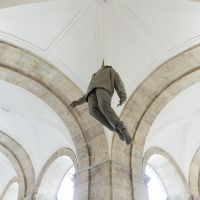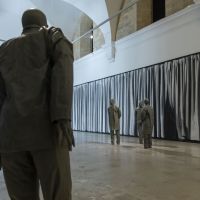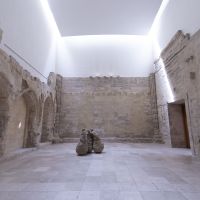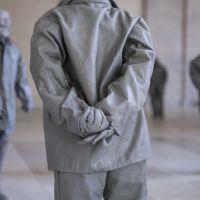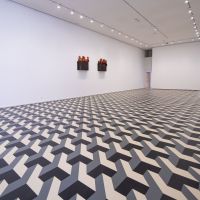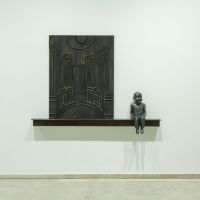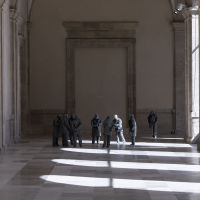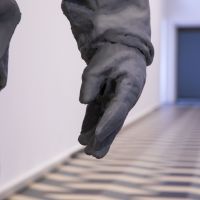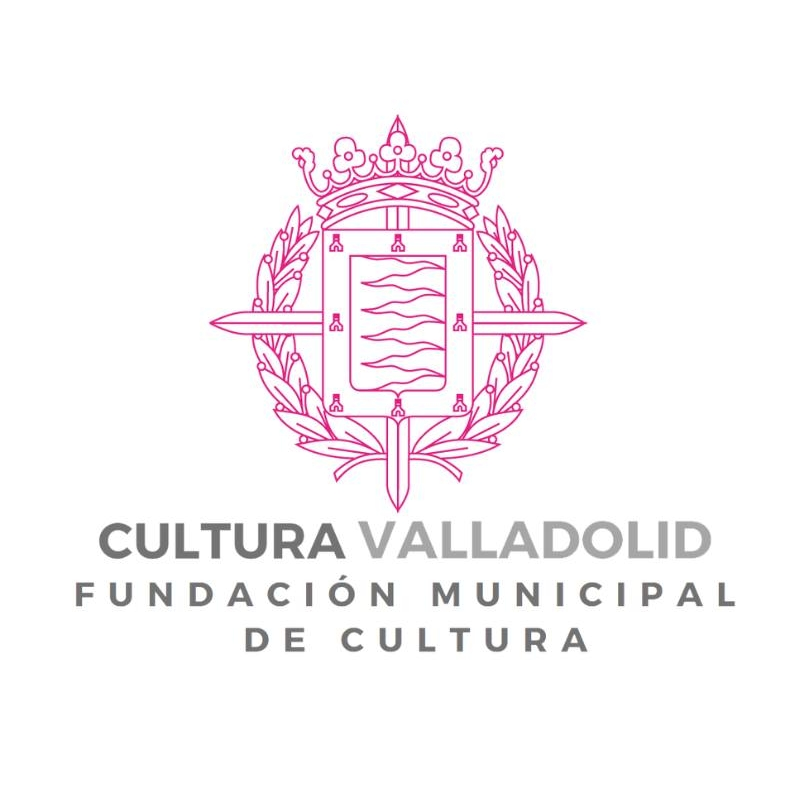TRES IMĂGENES O CUATRO
Juan Muñoz, veinte años

[English version below]
Se cumplen ahora veinte años de la muerte de Juan Muñoz y resuena todavĂa rotunda la relevancia de su legado. Su obra, sabemos, opera en una honda reflexiĂłn en torno al espacio, desde y hacia la mirada, con la representaciĂłn de la figura humana como centro pero sujeta a un desplazamiento consciente del punto de fuga que heredĂł de su interĂ©s por la tradiciĂłn barroca, esa que denominĂł, en una de sus muchas y brillantes afirmaciones, ârĂo de efectosâ. Esta tradiciĂłn, de hecho, se encuentra, tambiĂ©n, en uno de los orĂgenes de este proyecto, en las conversaciones mantenidas con Juan Carlos Arnuncio, arquitecto renovador del Museo Patio Herreriano y gran conocedor de la obra del arquitecto barroco Francesco Borromini, uno de los faros mĂĄs visibles en la obra de Juan Muñoz.Â
Esta exposiciĂłn quiere trenzar un diĂĄlogo entre un conjunto de obras cedidas por instituciones pĂșblicas y colecciones privadas con el fin de ofrecer una lectura de la obra del artista que se detenga ante los asuntos centrales de su carrera en el marco de la singular arquitectura del museo. Entre estas obras se encuentra Pieza escuchando la pared, de 1992, perteneciente a la AsociaciĂłn ColecciĂłn Arte ContemporĂĄneo, un clĂĄsico tentetieso en bronce que escucha no sabemos quĂ© y que, situado en uno de los claustros del museo, acentĂșa la relaciĂłn entre obra, espacio y espectador que Juan Muñoz explorĂł tenazmente a lo largo de su trayectoria.  La muestra tiene lugar en la Capilla de los Condes de Fuensaldaña, Sala 9, ambas en la planta baja, y en la Sala 8 de la planta segunda. Ocupa, ademĂĄs, otras zonas comunes del museo.
El tĂtulo de esta muestra, âTres imĂĄgenes o cuatroâ, estĂĄ tomado de otro de los textos emblemĂĄticos de un artista para quien la escritura fue un recurso prioritario. En Ă©l, Muñoz hace uso de muchas de sus herramientas narrativas y nos da pistas sobre cuestiones que, mĂĄs veladas o menos, aparecen en toda su obra, asĂ la espera. Como sabemos, Muñoz fue uno de los responsables de la recuperaciĂłn de la figura humana en el ĂĄmbito de la escultura, que habĂa sufrido una notable crisis de representaciĂłn en las dĂ©cadas precedentes, y que, a su regreso, lejos de conmemorar personajes o hechos histĂłricos alzada en su pedestal, permaneciĂł, ya fuera en grupo o en solitario, enmudecida y anĂłnima, por lo general a ras de suelo y en aparente relaciĂłn con el espectador. Insistamos en esto Ășltimo: la relaciĂłn que guardan con nosotros es solo aparente.Â
La literatura, y la dramaturgia en particular, encontrĂł un lugar preeminente en el imaginario artĂstico de Muñoz y de sus coetĂĄneos allĂĄ por los años ochenta, algo que entraba en conflicto con aquella tradiciĂłn por la que las obras de arte no decĂan nada que no fuera resultado de la reflexiĂłn en torno al propio arte. En el caso de Juan Muñoz, la teatralidad en su obra es narrativa y espacial a un mismo tiempo, una suerte de lenguaje que se inscribe en el lugar y que determina nuestra relaciĂłn con la obra de arte. En esta relaciĂłn reside una de las claves para entender todo el trabajo del artista, en un no saber si podemos formar parte de la obra y en un inquietante desconocer si somos convidados a participar de la silenciosa conversaciĂłn, cuando no discrepancia, de esas figuras que, en principio, demandarĂan, como toda obra de arte, nuestra atenciĂłn. Esta es una de las mĂĄs visibles paradojas en la obra de Juan Muñoz, el hecho de acercarse a sus conjuntos de figuras, como esa Conversation Piece (Hirschhorn), de 1995, que habita la Capilla de los Condes de Fuensaldaña, y comprobar el recelo que provoca en ellos nuestra presencia, obligĂĄndonos a repensar el lugar que ocupamos junto a ellos.
En los años posteriores a la muerte de Juan Muñoz convergieron mĂșltiples tendencias en los discursos en torno a la escultura. Destacaron entre ellas, por un lado, la vuelta a la estĂ©tica del Arte Povera, y por otro, las nuevas opciones formales y narrativas que brindĂł la irrupciĂłn de las tecnologĂas digitales en todos los aspectos de la sociedad contemporĂĄnea y tambiĂ©n, claro, en el arte. En ambos casos, Juan Muñoz ya habĂa estado ahĂ, ya fuera en la reconsideraciĂłn del lugar que ocupa la obra de arte en relaciĂłn con el espacio y con quien la observa que caracterizĂł la tradiciĂłn povera iniciada en Italia a finales de los sesenta, como en la reevaluaciĂłn de la ficciĂłn material y del trampantojo espacial que trajo el digital consigo y que el artista madrileño ya habĂa convertido en emblema de su propia obra.
Esta exposiciĂłn es consciente del enorme papel que juega la ficciĂłn en el imaginario contemporĂĄneo, y desde esa perspectiva ha construido su armazĂłn conceptual. Por ello, y como se advertĂa al principio de este texto, la tradiciĂłn barroca juega un papel importante, con ese canto a lo voluble, a lo inestable y lo fragmentario, al capricho efectista y a la ductilidad aparente de las formas. Esta idea reverbera con mĂĄs fuerza si cabe al tomar conciencia del lugar en el que nos encontramos, el vetusto escenario monĂĄstico de San Benito el Real, con su hermosa sobriedad renacentista, evocadora de un tiempo de verdades absolutas que se parece bien poco al que hoy vivimos.Â
Â
THREE IMAGES, MAYBE FOUR
Juan Muñoz. Twenty years on
It is now twenty years since the death of Juan Muñoz and the relevance of his legacy is still a resounding force. His work, we know, revolves around a profound reflection on space, from and towards the gaze, with the depiction of the human figure at its centre but subject to a conscious displacement of the vanishing point that he inherited from his interest in the Baroque tradition. In one of his many brilliant statements, he called it the âriver of effectsâ. This tradition, in fact, is also found in one of the origins of this project, in the conversations held with Juan Carlos Arnuncio, the architect who renovated the Patio Herreriano Museum and a great connoisseur of the work of the Baroque architect Francesco Borromini, one of the most visible beacons in the work of Juan Muñoz.
One of the purposes of this exhibition is to establish a dialogue among a group of works of art on loan from public institutions and private collections, in order to provide a reading of the artistâs work that addresses the central issues of his career within the framework of the museumâs unique architecture. Among these works of art is Piece Listening to the Wall , dating from 1992. It is a classic roly-poly toy made of bronze, belonging to the Contemporary Art Collection Association, listening to something we cannot identify. It is located in one of the museumâs cloisters, highlighting the relationship between work, space and viewer that Juan Muñoz tenaciously explored throughout his career. The exhibition is being held in the Chapel of the Counts of Fuensaldaña and in Room 9, both on the ground floor, and in Room 8 on the second floor. It also takes up other common areas of the museum.
The title of this exhibition, âThree images, maybe fourâ, is taken from another of the emblematic texts by our artist, for whom writing was a priority resource. Muñoz makes use of many of his narrative tools and gives us clues about issues that, more or less veiled, appear in all his work, such as waiting. As we know, Muñoz was one of those responsible for the recovery of the human figure in the field of sculpture, which had suffered a notable crisis of depiction in the preceding decades, and which, on its return, far from commemorating historical figures or events raised on a pedestal, remained, whether in groups or alone, mute and anonymous, generally at ground level and in apparent relation to the viewer. Let us insist on the latter: the relationship they have with us is only apparent.
Literature, and dramaturgy in particular, found a preeminent place in the artistic imaginary of Muñoz and his contemporaries back in the 1980s, something that conflicted with the tradition under which works of art said nothing that was not the result of reflection on art itself. In the case of Juan Muñoz, the theatricality in his work is narrative and spatial at the same time, a kind of language that is inscribed in the place and determines our relationship with the work of art. In this relationship lies one of the keys to understanding all the artistâs work, in not knowing if we can be part of it and in a disturbing lack of knowledge as to whether we are invited to take part in the silent conversation, if not discrepancy, of these figures that in principle would require our attention, just like any other work of art. This is one of the most visible paradoxes in the work of Juan Muñoz, approaching his groups of figures, such as Conversation Piece (Hirschhorn), dating from 1995, which inhabits the Chapel of the Counts of Fuensaldaña, and verifying the suspicion that our presence provokes in them, forcing us to rethink the place we hold at their side.
In the years following the death of Juan Muñoz, multiple trends converged in the discourses surrounding sculpture. Among them were, on the one hand, the return to the aesthetics of Arte Povera, and on the other, the new formal and narrative options provided by the coming of digital technologies in all aspects of contemporary society, and also, of course, in art. In both cases, Juan Muñoz had already been there, whether in the reconsideration of the place of the work of art in relation to space and to the observer characterizing the povera tradition initiated in Italy in the late 1960s, and in the re-evaluation of the material fiction and the spatial trompe l'oeil that came with digital technology, which our artist had already turned into an emblem of his own work.
This exhibition is well aware of the huge role that fiction plays in the contemporary imaginary, and from that perspective it has built up its conceptual framework. As we said right at the beginning of this text, the Baroque tradition plays a major role in its song to the voluble, the unstable and the fragmentary, the whimsical and the apparent ductility of forms. This idea reverberates even more powerfully when we become aware of the place in which we find ourselves, the ancient monastic setting of San Benito el Real, with its beautiful Renaissance sobriety, evocative of a time of absolute truths that bears little resemblance to the time we live in today.

